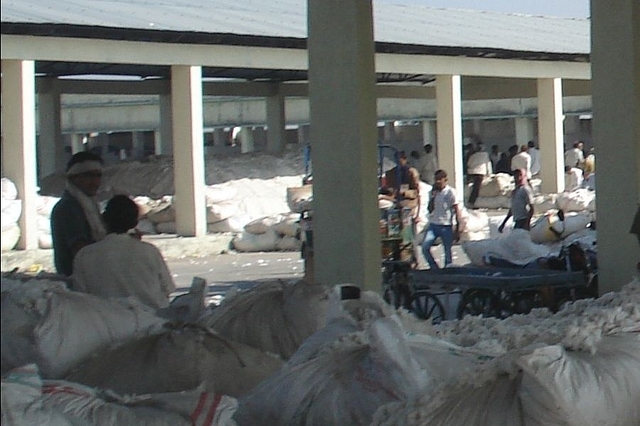
Spike In Cotton Prices: Modi Government Can Breathe Easy This Year
This time, farmers may harvest lower crop but higher prices should help compensate the loss.
That is one problem less for the Modi government.
Cotton prices are ruling higher currently compared with the same period a year ago. According to available data from the Ministry of Agriculture, Shankar-6 cotton, the benchmark variety, is quoting at over Rs 5,500 for a maund (20 kilogram). The raw cotton converted to pressed gin is quoting over Rs 46,500 a candy (356 kg).
Cotton prices are up for two reasons. One, production this year is estimated to be lower than last year. The Cotton Association of India, a body of traders, says production this season (October 2018-September 2019) will be 343.25 lakh bales (of 170 kg each) against 365 lakh bales last season.
Drought in parts of Maharashtra, Karnataka and Gujarat has affected cotton production this season. Gujarat alone is seeing a drop of 18 lakh bales in production, while in Maharashtra it is 3 lakh bales. In Karnataka, the crop is lower by 1.5 lakh bales compared with last year. The drop has been to some extent made up with higher output in Punjab, Haryana, Rajasthan and Madhya Pradesh.
The second reason is that cotton farmers, expecting prices to rise further, are cautious in bringing their stocks to the markets. From 1 October to 15 November, approximately 43 lakh bales of cotton have arrived at various market across the country. Compared to this, cotton consumption in the country for 45 days is about 45 lakh bales. In additional, at least 8 lakh bales have been exported. Thus, 53 lakh bales would have been consumed against arrivals that are nearly 10 lakh bales lower.
Now, it is likely that the shortfall could have been met from last season’s carryover stocks of 23 lakh bales. The carryover stocks from last season (also termed opening stocks for this season) are lower compared to 36 lakh bales. And at the end of the season, the carryover will drop to 15.25 lakh bales.
As a result of this estimates, prices increased sharply at the start of the new season. However, spinning mills, which consume 80 per cent of the total cotton production in the country, have been smart with their purchases. The mills are living hand-to-mouth and aren’t stocking up since it could affect their profit and liquidity. They are waiting for the prices to stabilise before making further purchases.
In view of this, cotton prices have eased a bit. Prices had run up over Rs 47,500 a candy initially but dropped below Rs 46,000 before ruling at current levels of Rs 46,500. Those in the trade say chances of sharp rise in prices are far less.
“Cotton farmers are expecting prices to run up to Rs 7,500 a candy. This is unlikely to happen since mills are cautious in their purchase and exports have slowed,” says a ginner from Rajkot. This means, any spike in the prices will be limited.
There are a couple of reasons for the any rise being limited. First, prices for export are not competitive. While domestic prices have climbed faster, the rupee gaining against the US dollar hasn’t helped either. The rupee is now around 72 to the dollar against 74 at the start of the month.
A stronger rupee makes exports uncompetitive. With the Cotlook A Index - the global benchmark for cotton prices - at 86.30, the rise in the rupee has made international buyers find purchase of cotton from India costlier. The third reason is that imports of cotton into India are estimated higher at 24 lakh bales against 15 lakh bales last year.
But these aren’t factors that should worry anyone, particularly the Narendra Modi Government at the Centre. Current cotton prices are higher than the minimum support price (MSP) of Rs 5,150 a quintal fixed by the Centre for this year against Rs 4,320 last year for medium staple cotton. Most of the cotton produced are of this variety. For the long staple variety, the MSP is Rs 5,450.
Last year, cotton prices were lower than MSP at this point of time. With the ruling Bharatiya Janata Party in Gujarat heading to election, it couldn’t afford to allow prices to rule lower. The Centre through the Cotton Corporation of India (CCI) stepped in with market intervention and bought over 2 lakh bales before prices began moving up. On its own, the CCI procures cotton for its commercial operations and this year, the organisation says it targets to buy 100 lakh bales.
The chances of firm cotton prices are bright with the market being supported by the latest report from the US Department of Agriculture (USDA). According to the USDA, global cotton production will be 3.5 per cent lower this season. Consumption will be 2.9 per cent higher than last year, while carryover stocks will be 12 per cent lower. The International Cotton Advisory Committee has forecast that prices of the fibre could rise to a five-year high this year.
Cotton has always been a tricky crop for any government. Either crop failure or lower prices or pest attack has been plaguing one time or the other. This time, farmers may harvest lower crop but higher prices should help compensate the loss. That is one problem less for the Modi government and probably help it as the Centre had raised the MSP by 23 per cent this year.